Text by Danny White
The South Central part of the US boasted some of the top funny cars of the 1980s. First-string players like Raymond Beadle, Kenny Bernstein, Billy Meyer, and Candies & Hughes were joined by lesser-known but competitive counterparts, including Jerry Jefferson, Mike Young, Chris Berg, Ron Dudley, Henry Phillips, and Eric Reed. — Updated March 19, 2008
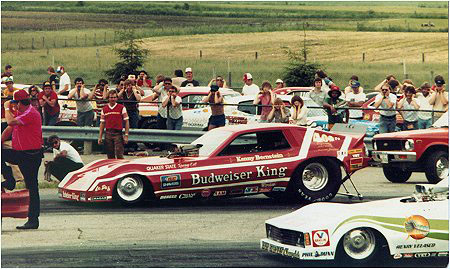
In 1981 Kenny Bernstein had Tony Casarez build him this Plymouth Horizon. This was only the second year for the Budweiser sponsorship of the Kenny Bernstein racing team. The tired and true 1/2″ stroke Keith Black Hemi was the engine of choice. Ray Alley was the tuner for Bernstein in 1981; he tuned Kenny to the third spot in the NHRA AA/FC standings. The Horizon ran a best of 5.86, 250 that year in the only year it was raced. (Photo courtesy of Rick Oldfield; info from Draglist files)
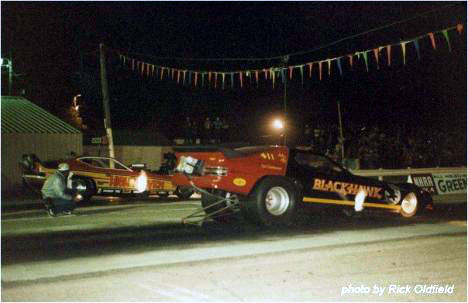
This is a rare shot of the Young Brothers Blackhawk Challenger. The Oklahoma-based team had raced funny cars off and on since the early seventies. The Challenger would be the last funny car they would race. The chassis was built by the late John Buttera with an updated Challenger body. Mike did the driving, and his brother Bernie did the tuning on the Blackhawk. The Blackhawk went a best of 5.97 in a match race at Union Grove. The team parked the car after the 1982 racing season. Bernie Young returned to racing with an Outlaw Top Sportsman a few years ago, while Mike Young stays retired. (Photo courtesy of Rick Oldfield; info from Mike and Bernie Young)
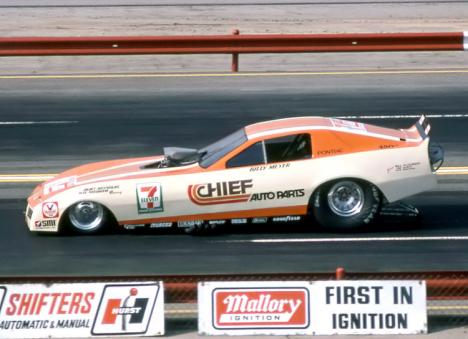
Billy Meyer’s 1982 Trans Am was a giant step forward in funny car aerodynamics. Despite a very stock appearance, the new TA was far superior to any other body in 1982. Meyer used the body and a large shot of nitrous oxide to run a 254 clocking at Englishtown that year. In 1982 nitrous was still legal for use in AA/FC but would be banned after 1982. Meyer ran a best of 5.75 in 1983 in the 7-11/chief Auto Parts Tran Am before being replaced by a Ford Mustang. (Photo Courtesy of Mike Ditty; info from Mike Ditty)
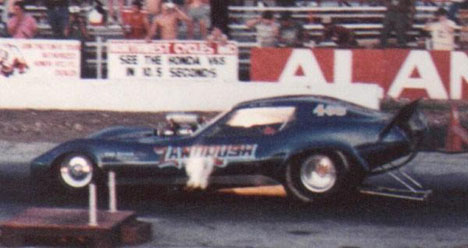
Jerry Jefferson had raced funny cars and top fuelers in the seventies before retiring from racing in 1980. In 1985, Jefferson bought the Moby Dick Corvette from fellow Oklahoman Ezra Boggs. As seen in the photo, the Corvette was repainted with the Oklahoma Landrush paint job. Bad luck would befall the Oklahoma Landrush on this run as it caught fire on this run. The damage would result in a new paint job for the Corvette. Jefferson would run a best of 6.31 in the Corvette by early 1986; the car was replaced by a new car in the middle of the year. (Photo courtesy of Dennis Roetman; info from Draglist files)
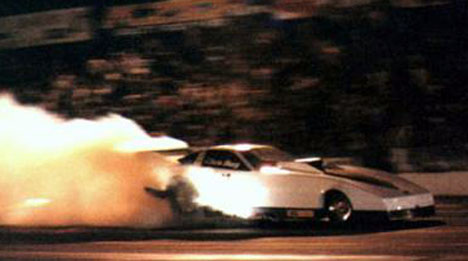
Chris Berg was a longtime match racer from Texas. Berg had relocated from New York to Schertz, Texas. In 1978 Berg had T-Bar Chassis build him a Dodge Challenger that he raced over the next eight years. In the middle of the 1986 season, Berg mounted a new Odyssey Corvette body on the chassis. Berg only ran the new body a couple of times in 1986. Berg ran his best ever by three-tenths of a second at Ennis with a 6.057, 240 run in his final race. (Photo courtesy of Dennis Roetman; info from Draglist files)
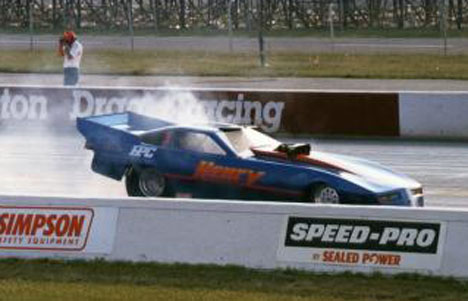
Henry Phillips was an alcohol dragster racer before making the big step up to nitro funny car racing in 1986. Phillips made a trip to Frank Hawley’s Drag Racing School to drive a funny car. Philips got his nitro license later in 1986 in his new Dodge Daytona tuned by funny car racer Ron Rice. In 1987, Phillips made one of the best one-off runs of the decade with a 5.60, 247 run at Ennis. The run destroyed the body on the run forcing Phillips and Rice to get a new Corvette body. The team never was able to duplicate the 5.60 run from Ennis. Henry Phillips burned the car to the ground at Indy 87 on live TV and never rebuilt the car. (Mike Beach photo courtesy of Curt Swartz; info from Ron Rice and Draglist files)
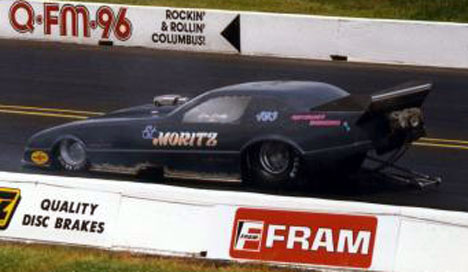
In 1987, Dick Moritz needed a new driver to drive the St. Moritz funny car to replace Jim White, who left to drive for Roland Leong. Ron Dudley was the driver Moritz chose. Dudley had raced fuel altereds and, most recently, Top Alcohol Dragsters. Dudley drove the team’s Daytona in 1987. In 1988, a new St. Moritz Beretta was built. The new Rick Ballentine tuned car debuted at Columbus at the Spring Nationals. The new car ran a best of 5.69, 263.85, but caught on fire. Dudley’s massive, long-lasting fire soon made the 6″ holes in the side windows mandatory on all FCs so that fire hoses could be shoved into the car if the driver was trapped inside. Dick Moritz retired from funny car racing after the fire. Dudley would not return to drive for a decade. (Photo courtesy of Curt Swartz; info from Curt Swartz and Draglist files)
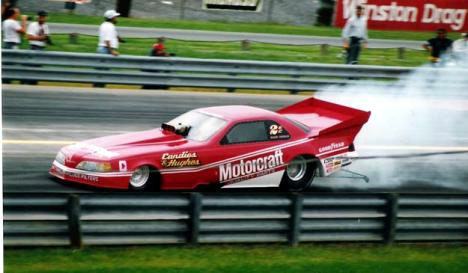
Mark Oswald was one of the top funny car racers of the eighties. Oswald drove for the Candies & Hughes team out of Louisiana. In 1987, Candies & Hughes built a new Thunderbird funny car with backing from Motorcraft. The team finished number two in NHRA Points to Kenny Bernstein. The team ran a best of 5.35, 276 in the swoopy T-bird in the year of the Batmobile funny cars. The team had to replace the body for 1988 due to the molded spoiler. (Photo Courtesy of Tom Kasch; info from Draglist files)
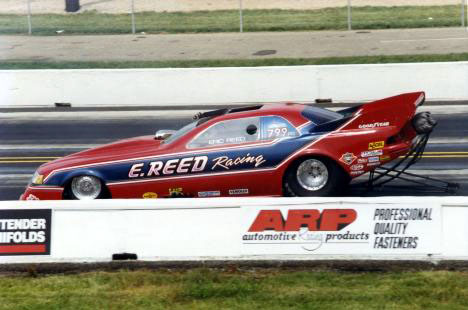
Eric Reed was not a native Texan but relocated his funny car team to Irving in 1988. The young African American racer had raced Pro Stock Motorcycle before building a funny car in 1987. Reed raced funny cars over the next two years, running a best of 5.43, 272.89 in 1989 with his Thunderbird. Reed’s legal problems caught up with him by 1989, forcing him to retire from racing. (Mike Beach photo courtesy of Curt Swartz; info from Draglist files)

This was the final Blue Max funny car owned by Raymond Beadle, ending a 15-year period where he was NHRA World Champion three times. Ronny Young was chosen to drive the final Blue Max at the end of 1988 to replace Richard Tharp. Young showed he could drive nitro funny cars after racing Pro Stockers and alcohol funny cars. Young recorded a best of 5.44, 264.55 in the car in 1988. Young drove the car through the 1989 season before Beadle sold the team to Gordon Mineo. (Photo courtesy of John Kilburg; info from Draglist files)
